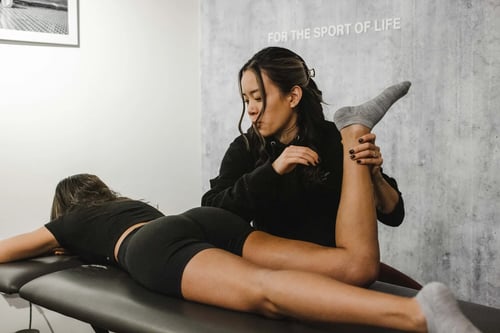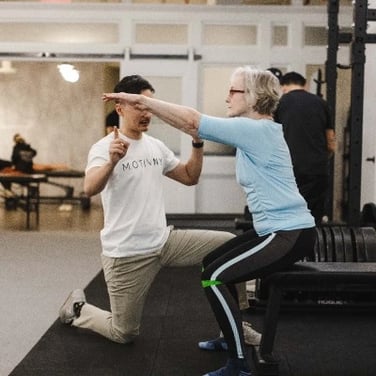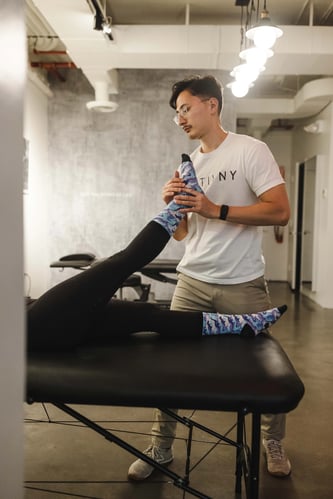Physical Therapy 101: The Ultimate Guide to All Things Physical Therapy
You can recover faster and perform better with the right physical therapy program. But where should you start? Learn everything you need to know about physical therapy, including what it is, why you should care, and how you can get started.
What Is Physical Therapy?
What Conditions Does Physical Therapy Treat?
Benefits of Physical Therapy
What Does a Physical Therapist Do?
Is a Physical Therapist a Doctor?
How Do I Find the Right Physical Therapist?
What Does a Typical Physical Therapy Session Look Like?
How Much Does Physical Therapy Cost?
Is Manual Physical Therapy the Same as Physical Therapy?
What Does Manual Physical Therapy Do?
Is Stretching Considered Manual Physical Therapy?
Does Manual Physical Therapy Actually Work?
What’s the Holistic Approach to Physical Therapy?
Who Is Specialized Physical Therapy for and What Are the Specific Types?
Is Sports Medicine the Same as Physical Therapy?
What Is the Role of a Sports Physical Therapist?
Treatment Modalities Offered at MOTIVNY
Introducing Physical Therapy: What It Is & Why We Care
Most injuries, aches, or pains won’t just resolve themselves. Physical Therapy is here to address your needs by guiding you through the process of recovering from an injury or event or adjusting your lifestyle to suit the demands that you have.
A Physical Therapist should listen to your story first, pay attention to the points most important to you, and look carefully for cues about where you might be going wrong in your activities.
Physical therapy may be suitable for an obvious injury, like a muscle strain from playing sports, or a broken bone that has been immobilized for a while. It may also be applicable for a more insidious onset of pain or problems having to do with your lifestyle, overuse, or mismatch between expectations and demands.
If you’ve ever tried to manage an injury yourself, it may be evident that sometimes there are factors that are difficult to identify in your own body. A trained therapist is an expert at identifying these areas, helping to make you aware of them, and giving advice about how to make improvements to eliminate those issues. Your insurance provider may aid in covering the costs of physical therapy, or you may have to pay out of pocket if you don’t have coverage that applies.
Physical therapy should be an integrative experience. That includes education, coaching, manual or exercise therapy, treatment modalities to manage pain, and support for your psychological well-being as your venture through your recovery journey.
You're probably here because you have some questions about physical therapy, treatment modalities, specialties, an injury, or MOTIVNY and our practice. We've compiled this guide to help answer some of the most common questions we receive to help you get started on your physical therapy journey.
The Basics of Holistic Physical Therapy
What is physical therapy?
In physical therapy, a licensed professional with a Clinical Doctorate degree uses history, assessment, and testing to create a strategy that allows a client or patient to return to their normal activities. Even if you aren’t injured, physical therapy may be able to help you identify limiting factors that have not allowed you to reach your goals.

What conditions does physical therapy treat?
Physical therapists treat a wide range of issues ranging from post-op and acute injury recovery to maintenance and performance management. One of the key things that we offer at MOTIVNY that sets us apart is that we are here to support you through every step of your journey.
Below are some of the most common reasons people sign up to see one of our therapists.
- SPORTS SPECIFIC INJURY: Tennis Elbow, Runner's Knee, Swimmer's Shoulder
- HAND: Post Surgery, Splints, Epicondylitis
- SHOULDER: Rotator Cuff, Tendonitis, Labral Pathology, Upper Cross Syndrome, Subluxations
- NECK: Kinks and Stiffness, Headaches/Migraines, Trigger Points, Dizziness
- BACK: Herniated Disc, Postural Dysfunction, SI Joint, Stenosis, Sciatica
- HIP: Osteoarthritis, Bursitis, Labral Pathology, Impingement
- KNEE: Tendonitis, ACL, Patellofemoral, Meniscus, Iliotibial Band Syndrome, Osteoarthritis
- ANKLE & FOOT: Plantar Fascistic, Sprain, Strain, Shin Splints, Achilles Injury.
Physical benefits of physical therapy
Outside of the obvious benefit of helping to address a specific issue, you may be having, regular physical therapy, especially when looked at as part of a maintenance or performance plan can bring numerous physical benefits to patients, including:
- Reduce/eliminate pain
- Rehab/recovery
- Prevent injury
- Enhanced flexibility
- Improve movement quality
Mental & lifestyle benefits of physical therapy
- Mental health: Being in pain can be a difficult and stressful state of mind for anyone. When you work with your therapist, their empathetic nature should help to aid in decreasing your stress level about the injury. Furthermore, when learning from the therapist about what you CAN do to improve your situation and reduce pain, you should feel empowered that you can feel yourself again soon.
- Mood: Exercise is a great mood elevator. If you’ve been unable to exercise, it’s understandable to be a little bit bummed. Physical therapists are trained to identify what you still can do, even if you are injured, and help you get back into your routine.
- Sleep quality: Pain and injuries can make it uncomfortable to rest. If this is an issue you have, your therapist may recommend specific stretches, breathing exercises, or routines to help you get to bed more easily or have fewer reasons to toss and turn when you go to sleep. Keep in mind that your sleep is a reflection of your lifestyle during the day, and you may need to make adjustments there as well.
Physical Therapists: What They Do
What does a physical therapist do?
A physical therapist helps people recover from physical injuries, whether they are chronic or acute, and whether they were caused by sports or lifestyle factors. A physical therapist’s goals are to reduce your pain, improve your functional movement, and maximize your mobility and strength to help you return to the lifestyle you want to live.

How does someone become a physical therapist?
After college, aspiring physical therapists attend a 3-year clinical doctorate program to become Doctors of Physical Therapy. During physical therapy school, students also go through clinical rotations to practically apply what they’ve learned, similar to medical doctors going through an internship before they become resident doctors.
Is a physical therapist a doctor?
Yes! Similar to how dentists are doctors that specialize in teeth, physical therapists are doctors that specialize in rehabilitation and physical medicine.
How do I find the right physical therapist?
It is often hard to distinguish between a great physical therapist and a mediocre one because holistic physical therapy primarily includes asking nuanced questions and listening carefully. These soft skills may be hard for the average person to notice but can change your experience drastically.
A physical therapist that is taking a holistic approach will:
- Consider psychosocial factors such as stress and fear that relate to or exacerbate physical discomfort
- Perform a comprehensive assessment of your body that includes a detailed history taking and a hands-on examination
- Provide coaching on lifestyle management to help control extraneous variables
- Connect with your medical providers and/or personal trainers to collaborate on a well-rounded plan together.
Physical Therapy in New York: Making an Appointment
What does a typical physical therapy session look like?
A typical physical therapy session ranges anywhere from 25-30 minutes. Here at MOTIVNY, every treatment session is an hour-long where you are working one on one with your therapist.
New patient appointments
The Intake: After your therapist has read any relevant intake forms and prescriptions to gain a baseline understanding of your issues, they will then walk you through an interview to better understand a patient's story. It helps to hear this in a patient's own words to understand what happened and what the biggest issues or limitations are.
The Assessment: After discussing your concerns, your therapist will conduct a series of objective assessments surrounding your area of concern, or if your concern is more general, will conduct a full-body movement analysis.
All appointments
Manual therapy: Every appointment starts with at least 25-30 minutes of manual, hands-on treatment with your therapist. This includes palpation and joint mobilizations either with a therapist's hands, band, or various other tools. Your therapist will use this time to assess and treat different parts of the body to see what may be limited at a deeper level.
Therapeutic Exercise & Neural Grooving: Once you've been mobilized and identified your biggest areas of opportunity for the day, you and your therapist will hit the mats for some prescriptive exercises. These can range from basic bodyweight moves to exercises with bands, dumbbells, kettlebells, or even a barbell. We are firm believers in the importance of strength training in every recovery program.
Your therapist will guide you through each exercise to ensure proper technique, that your body is responding accordingly, and that the prescribed exercise suits your current skill and fitness level.
Prescribed Treatment Plan: Together, you and your therapist will close out your session by discussing your treatment plan and progress. Every patient walks away from an appointment at MOTIVNY with concrete examples of exercises they can incorporate into their daily lives to help improve their recovery. You will also schedule any necessary future appointments, discuss the expected time remaining on your treatment plan, and what future sessions could look like. We are all about being transparent to ensure you are fully engaged and understand where you're at in your recovery journey.
Home Exercise Plan: Your therapist will also build out an at home exercise plan in our app, which includes reference videos and suggested sets and reps help you recover faster and get back to The Sport of Life!
How Much Does Physical Therapy Cost?
Short answer....it depends and can vary throughout the year!
We are an out-of-network provider, so depending on your insurance coverage, the cost of an appointment can be anywhere from $0 to $300. Your copay will vary throughout the year as you get closer to hitting your deductible or out-of-pocket max.
We offer all patients a max out-of-pocket cost per appointment of $195 ($275 for our founders). We call this our self-pay rate and patients will never be asked to pay for costs beyond this out of their pocket.
If your insurance is helping to cover physical therapy, your out-of-pocket costs may vary from $30 to possibly $100 per session, and your insurance should pay for the rest.
If your insurance isn’t helping to pay, your out-of-pocket expense will be the cost of the entire visit. This depends on provider and location, but you can expect the cost to be anywhere from $150-$300 for an hour-long appointment. This will vary based on the experience level and availability of the therapist you select to work with.
As an out-of-network provider, we don't require that patients have insurance, and they don't need a prescription to see one of our therapists. Because of this, we’re able to offer hour-long appointments at MOTIVNY instead of the industry standard of 30 minutes.
Manual Physical Therapy
Is manual physical therapy the same as physical therapy?
No. Manual therapy is a subset of physical therapy where the physical therapist uses a hands-on approach rather than equipment or machines. Manual therapy includes but is not limited to manipulating joints, mobilizing soft tissue, fascial taping, and functional release. A physical therapist may or may not use manual therapy within a session with you, depending on your body’s needs.
What does manual therapy do?
Manual therapy relies on the expert touch and knowledge of the physical therapist to assess and cater specifically to the needs of your body. This includes assessing the mobility and strength patterns of your body or noticing the level of pain or sensitivity to the movement you experience. Manual therapy can then be used to influence the extensibility of a muscle or joint, or calm down an overly stimulated nervous system, all based on the prior expert assessment.
Is stretching considered manual therapy?
Stretching can be considered manual therapy if the physical therapist is performing the stretch on you rather than you doing it yourself. That being said, passive stretching is not usually the primary method of choice used by manual therapists, as it IS something that you can do at home.
Does manual therapy actually work?
There is a myriad of high-level evidence supporting the efficacy of manual therapy in today’s medical literature. More specifically, most methods within manual therapy have been extensively studied and have been proven or refuted, while the jury is still out on newer therapies. To know which manual therapy methods are most effective for you, it is best to find a physical therapist who subscribes to evidence-based practices and has kept up with the latest research.
Holistic & Specialized Physical Therapy
What’s the holistic approach to physical therapy?
It is often hard to distinguish between a physical therapist that takes a holistic approach to your rehabilitation and one that does not because holistic physical therapy primarily includes asking nuanced questions and listening carefully. These soft skills may be hard for the average person to notice but can change your experience drastically.
Specialized physical therapy: Who is specialized physical therapy for and what are the specific types?
Geriatric: For our dearest elderly grandpas and grandmas
Pediatric: For the little ones, often those with developmental delays or conditions
Neurological: For nervous system injuries such as a stroke or traumatic brain injury
Hand: Certified specialists undergo extra training for treating the hand
Orthopedic: This is the most general catch-all category of physical therapy, as orthopedic just refers to anything involving your musculoskeletal system. Therefore, unless you fall in a more specific category such as geriatric or neurological, you would be considered an orthopedic patient.
Occupational therapy: Is a completely different type of rehabilitation than physical. Occupational therapists are educated through different programs, and while they work in tandem with physical therapists a lot of the time, they are technically separate fields. Occupational therapists help their patients relearn to perform everyday tasks such as writing, eating with silverware, or brushing their teeth.
Holistic care occurs within each of these specialized fields of physical therapy. The holistic approach occurs when the physical therapist listens empathetically, assesses thoroughly, and employs a range of techniques as required by the specific case, and this approach should be taken by any physical therapist, regardless of specialization.
Sports Medicine Physical Therapy
Is sports medicine the same as physical therapy?
Sports medicine is a branch of medicine that deals with physical fitness and the treatment and prevention of injuries related to sports and exercise. As integral members of the sports medicine team, which includes medical doctors, athletic trainers, dietitians, and other healthcare providers, physical therapists are responsible for carrying out an athlete’s plan of care and helping them return to their sport after an injury.
What is the role of a sports physical therapist?
What makes sports physical therapists unique is their knowledge of biomechanics and the demands that sports impose on the body. Using this knowledge, they can tailor interventions to ensure athletes aren’t just recovering from injury but returning to competition stronger than before. This is accomplished through objective testing that provides measurable indicators of progress while integrating principles of motor learning to help athletes become more skillful movers in the rehabilitation process.
Given the dynamic and variable nature of competition, sports physical therapists are also trained in leveraging what makes each athlete unique and maximizing skill acquisition throughout the rehabilitation process. Athletes emerge from their injury with increased body awareness and the skills to independently address rate limiters to peak performance in their sport while preventing future injury.
Examples of Specific Physical Therapy Systems Used at MOTIVNY
-
Functional range release
-
Functional range conditioning (FRC)
-
Spinal manipulation
-
Fascial movement taping
-
Instrument Assisted Soft Tissue Mobilization
-
Strength Training
-
Running assessment
-
Movement analysis
Physical Therapy: The Conclusion
My Journal Posts
All Journal PostsStrength vs. Flexibility: Striking a Balance
In the realm of fitness, two components often stand at opposite ends of the spectrum: strength and flexibility....
Coach's Corner: Simple Strategies to Implement Mobility Into your Week
In a world where time is a precious commodity, finding a moment to squeeze in a workout can be challenging, let...




